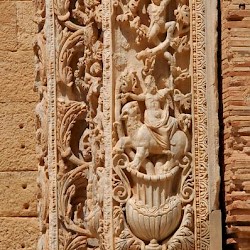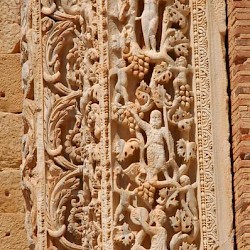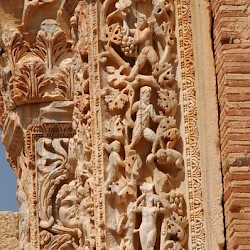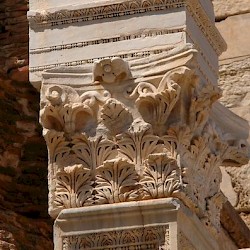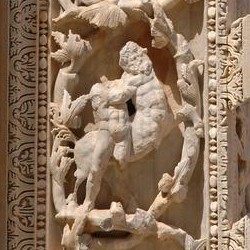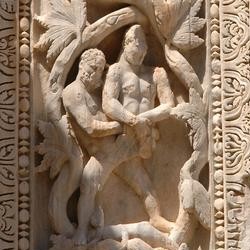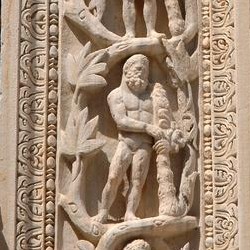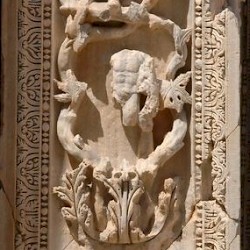Lepcis Magna, Severan Basilica
Q2124732Lepcis Magna: Phoenician colony, later part of the Carthaginian empire, the kingdom of Massinissa, and the Roman empire. Its most famous son was the emperor Septimius Severus (r.193-211).
Severan Basilica
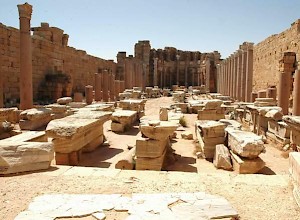
The Severan Basilica is perhaps Lepcis' most famous monument, after the Arch of Severus. The two monuments belong together. The arch was offered to the emperor Septimius Severus (r.193-211) on the occasion of his visit in 203 CE, and the emperor responded by offering the basilica, which was part of a larger project of urban renewal that is, frankly, a bit unimaginative, although the decorated columns in the basilica are splendid.
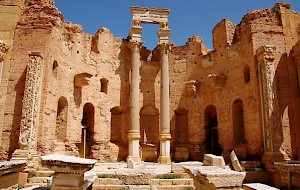
The basilica, which is inspired on the Basilica Ulpia in Rome, belongs to the Severan Forum, which in the southwest was closed by a Temple to the Septimius family, and in the northeast by the Severan Basilica. The basilica was about 95 meters long and 35 wide, and was divided into three naves, separated from each other by rows of columns made of Egyptian purple granite. At the two ends were apses, which had slightly raised platforms that may have been used by magistrates. This suggests that the basilica was used for (among other activities) legal hearings.
The little griffin on the photo below is a remarkable addition to a typical column, as it is placed between the capital and the architrave.
Inscription
The inscription on the architrave (IRT 428) describes how Septimius Severus started to build the basilica. This part of the text is remarkable because many of the common abbreviations, like IMP, and numerals are spelled out in full. The second part mentions how Severus' son and successor Caracalla (r.211-217) finished the building.
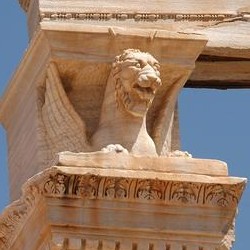 Lepcis, Severan Basilica, northern apse, griffin |
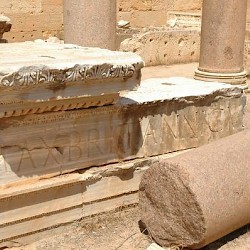 Lepcis Magna, Severan basilica, inscription |
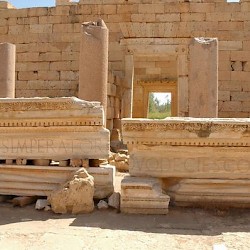 Lepcis Magna, Severan basilica, inscription |
 Lepcis Magna, Severan basilica, inscription |
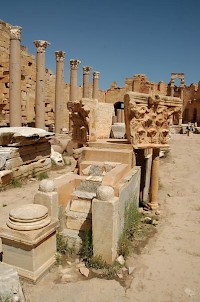
At first sight, the inscription appears to date the beginning of the building to Septimius' last year, because his title Britannicus Maximus and his eighteenth year if tribunicial powers are mentioned, but the text was in fact written after his death, and the makers used the emperor's fullest titulature. The long title of Caracalla can be summarized to "completed in 216", but misses the point: in an age in which people could not read silently, someone reading the inscription would mention all titles of the emperor - showing of that he was capable of reading, and effectively legitimating Caracalla's rule.
Church
In 533, the Byzantine general Belisarius ordered the basilica of Septimius Severus to be restored. It was converted into a church, dedicated to Mary, the Mother of God. The pulpit, which was made from an old capital, as if to show that the old gods were powerless. There was also a baptistery, in the shape of a cross, but we forgot to make photos of it.
Columns
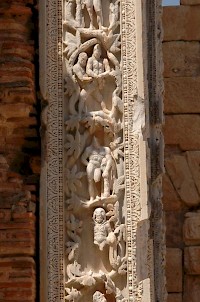
The decoration of two columns in the basilica is particularly fine. One of them contains representations of Hercules, the other one of Dionysus. Since Phoenician times, they had been the city's protectors, although back then, they were called Melk'ashtart and Shadrapa.
The column of Dionysus, or, as the Lepcitanians often called him, Liber Pater ("Father Freedom"), is decorated with all kinds of vines and garlands, but we can also discern, among many other dionysiac themes, centaurs, and the god Pan. Silenus, Bacchantes, panthers, and a drunk god are of course not missing.
The column of Hercules showed several scenes from his life. These include the Twelve Labors, but also other scenes. It is interesting to notice that famous ancient sculptures, like Lysippus' statue of a very musclar demigod (known as the "Farnese Hercules"), have been included too.
